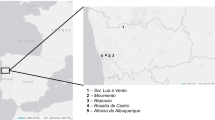Abstract
Stone monuments situated in the Alexander Nevsky Abbey, the Summer Garden, and the Smolenskoe Cemetery, St. Petersburg, and marble and limestone sculptures and tombstones situated in the Novodevichy Convent and the Donskoy Monastery, Moscow, were investigated for their microbial contamination. The architectural objects studied date back to the 12th century. The monuments in the Alexander Nevsky Abbey were found to be severely contaminated with micromycetes belonging to 24 genera (primarily of the class Deuteromycetes). The analysis of the samples taken from the monuments of the Donskoy Monastery by the serial dilution technique showed that they were contaminated with bacteria at a density of (1–1.7) × 105 cells/g. This value, however, turned out to be 1 to 2 orders greater when the bacterial population was evaluated by the luciferin–luciferase method. We succeeded in identifying 12 bacterial genera; however, this number may be increased in the course of further studies. Some preventive measures to control the biodeterioration of stone heritage are discussed.
Similar content being viewed by others
REFERENCES
Gromov, B.V., The Microflora of Deteriorating Brick, Plaster, and Marble, Vestn. Len. Univ., Ser. Biol., 1963, no. 3, pp. 69–77.
Lyalikova, N. and Petushkova, Yu., Role of Microorganisms in the Weathering Minerals in Stone of Historical Buildings, Geomicrob. J., 1991, vol. 9, pp. 91–101.
Bock, E., Diercks, M., Krause-Kupsch, Th., Lin, L., Meincke, M., Sameluck, F., Sand, W., and Spieck, E., Belastung von Natursteinen durch salpetersaeurebildende Bakterien: Eine Bewertung am Beispiel ausgewaehlter Bauwerke, Jahreberichte Steinzerfall-Steinkonservierung, Berlin: Ernst und Sohn, 1989, pp. 47–56.
Griffin, P.S., Indictor, N., and Koestler, R.J., The Biodeterioration of Stone: A Review of Deterioration Mechanisms, Conservation Case Histories, and Treatment, Int. Biodeterioration, 1991, vol. 28, pp. 187–208.
Krumbein, W.E. and Urzi, C., Microbiological Impacts on the Cultural Heritage with Special Reference to Rock Materials, La Pietra Dei Monumenti Nel Suo Ambiente Fisico, Lefevre, R., Ed., Instituto Poligrafico Roma, 1993, pp. 151–178.
Warscheid, Th. and Krumbein, W.E., Biodeterioration sprozesse an anorganischen Werkstoffen und moegliche Gegenmassnamen, Werkstoffe Korrosion, 1994, vol. 45, pp. 105–113.
Saiz-Jimenez, S., Deposition of Anthropogenic Compounds on Monuments and Their Effect on Airborne Microorganisms, Aerobiologia, 1995, vol. 11, pp. 161–175.
Sterflinger, K., Geomicrobiological Investigations on the Alteration of Marble Monuments by Dematiaceous Fungi (Sanctuary of Delos, Cyclades, Greece), PhD Thesis, Oldenburg, 1995.
Wollenzien, U., de Hoog, G.S., Krumbein, W.E., and Urzi, C., On the Isolation of Microcolonial Fungi Occurring on and in Marble and Other Calcareous Rocks, Sci. Total Environ., 1995, vol. 167, pp. 287–294.
Diakumaku, E., Investigations on the Role of Black Fungi and Their Pigments in the Deterioration of Monuments, PhD Thesis, Oldenburg, 1996.
Gorbushina, A.A., Vlasov, D.Yu., Panina, L.K., and Krumbain, V.E., Fungi Deteriorating Marble in Cherson, Mikol. Fitopatol., 1996, vol. 30, pp. 23–28.
Braams, J., Ecological Studies on the Fungal Microflora Inhabiting Historical Sandstone Monuments. PhD Thesis, Oldenburg, 1992.
Ugarova, N.N., Brovko, L.Yu., Tradatyan, I.Yu., and Rainina, E.I., Bioluminescence Analysis in Microbiology, Prikl. Biokhim. Mikrobiol., 1987, vol. 23, pp. 14–24.
Thore, A., Chemoluminescent Analysis in Microbiology, Helsinki, 1981, p. 48.
De Leo, F., Criseo, G., and Urzi, C., Impact of Surrounding Vegetation and Soil on the Colonization of Marble Statues by Dematiaceous Fungi, Int. Congr. on Deterioration and Conservation of Stone, 1996, pp. 625–630.
Zenova, G.M., Shtina, E.A., Dedysh, S.N., Glagoleva, O.B., Likhacheva, A.A., and Gracheva, T.A., Ecological Relations between Algae in Biogeocenoses, Mikrobiologiya, 1995, vol. 64, pp. 149–164.
Author information
Authors and Affiliations
Rights and permissions
About this article
Cite this article
Gorbushina, A.A., Lyalikova, N.N., Vlasov, D.Y. et al. Microbial Communities on the Monuments of Moscow and St. Petersburg: Biodiversity and Trophic Relations. Microbiology 71, 350–356 (2002). https://doi.org/10.1023/A:1015823232025
Issue Date:
DOI: https://doi.org/10.1023/A:1015823232025




